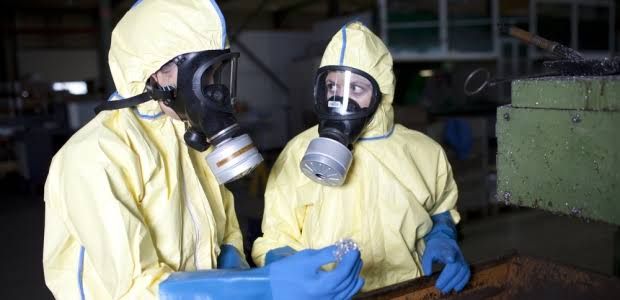
Types of Occupational Hazards That Affect the Respiratory System
Occupational hazards that impact the respiratory system are primarily caused by exposure to harmful substances or conditions in the workplace. These hazards can lead to various respiratory diseases, some of which may be chronic and irreversible. Below is a detailed enumeration of these hazards:
- Dusts
- Silica Dust: Found in mining, construction, and stone cutting industries, silica dust can cause silicosis, a condition characterized by lung scarring.
- Coal Dust: Inhalation of coal dust leads to coal workers’ pneumoconiosis (black lung disease), which results in inflammation and fibrosis of the lungs.
- Organic Dusts: Dust from cotton, flax, or hemp processing can cause byssinosis (brown lung disease), particularly affecting textile workers.
- Fibers
- Asbestos Fibers: Exposure to asbestos fibers, common in insulation and construction work before the 1970s, causes asbestosis and increases the risk for mesothelioma and lung cancer.
- Fumes and Vapors
- Fumes from welding or metalworking can irritate the respiratory tract and lead to chronic obstructive pulmonary disease (COPD).
- Vapors from chemicals like formaldehyde or solvents used in manufacturing processes can trigger occupational asthma or other respiratory issues.
- Gases
- Toxic gases such as ammonia, chlorine, or sulfur dioxide—common in chemical plants—can cause acute irritation or long-term damage to lung tissue.
- Biological Agents
- Exposure to fungal spores (e.g., Coccidioides causing Valley fever) or bacteria (e.g., tuberculosis) is common among healthcare workers, farmers, and those handling organic materials like moldy hay.
- Allergens
- Allergens such as animal dander (in veterinary work) or plant proteins can lead to hypersensitivity pneumonitis or occupational asthma.
- Infectious Pathogens
- Workers exposed to airborne pathogens like tuberculosis (Mycobacterium tuberculosis) or influenza are at risk for occupationally acquired infections.
- Environmental Conditions
- Poor ventilation in workplaces can exacerbate exposure to airborne contaminants and increase risks for respiratory illnesses like COPD.
Diagnostic Techniques Used in Occupational Medicine
Diagnosing work-related respiratory illnesses involves a combination of clinical evaluations, imaging studies, laboratory tests, and workplace assessments:
- Medical History and Workplace Exposure Assessment
- A detailed medical history focusing on symptoms such as coughing, wheezing, shortness of breath, chest pain, and their correlation with workplace exposures is critical.
- Understanding job roles and potential exposure sources helps identify specific hazards.
- Pulmonary Function Tests (PFTs)
- Spirometry measures airflow obstruction by assessing forced expiratory volume (FEV₁) and forced vital capacity (FVC). It is commonly used for diagnosing conditions like COPD or asthma caused by occupational exposures.
- Imaging Studies
- Chest X-rays are used to detect abnormalities such as scarring (as seen in silicosis or asbestosis).
- CT scans provide more detailed images of lung structures for identifying fibrosis patterns associated with diseases like hypersensitivity pneumonitis.
- Bronchoscopy
- This technique uses a flexible tube inserted into the airways to visualize internal structures directly.
- Biopsy: Tissue samples are collected for histopathological examination.
- Bronchoalveolar Lavage: Fluid samples are analyzed for signs of inflammation or infection.
- This technique uses a flexible tube inserted into the airways to visualize internal structures directly.
- Blood Gas Analysis
- Arterial blood gas tests measure oxygen and carbon dioxide levels in the blood to assess lung function impairment due to occupational diseases like COPD.
- Allergy Testing
- Skin prick tests or serum IgE levels help diagnose allergic reactions contributing to hypersensitivity pneumonitis or occupational asthma.
- Microbiological Testing
- Cultures from sputum samples help identify infectious agents such as Mycobacterium tuberculosis in cases of suspected tuberculosis.
Investigating Work-Related Respiratory Illnesses
The process of investigating work-related respiratory illnesses involves several steps aimed at identifying causative factors while ensuring worker safety:
Step 1: Initial Assessment
- Collect a comprehensive medical history focusing on symptoms related to workplace exposures.
- Document job roles, duration of employment, protective measures used (e.g., respirators), and known hazardous materials handled.
Step 2: Workplace Evaluation
- Conduct an on-site assessment with occupational health experts:
- Identify potential sources of airborne contaminants.
- Evaluate ventilation systems.
- Assess compliance with safety regulations.
Step 3: Diagnostic Testing
- Perform relevant diagnostic tests based on suspected conditions:
- Pulmonary function testing for airflow limitation.
- Imaging studies for structural damage.
- Bronchoscopy if deeper investigation is required.
Step 4: Hierarchy of Controls Implementation
- Apply control measures using the hierarchy framework:
- Eliminate hazardous substances where possible.
- Substitute less harmful materials if elimination is not feasible.
- Implement engineering controls such as improved ventilation systems.
- Enforce administrative controls like rotating shifts to minimize exposure time.
- Ensure proper use of personal protective equipment (PPE).
Step 5: Monitoring & Follow-Up
- Regular monitoring through spirometry tests ensures early detection of progressive conditions.
- Follow-up visits assess symptom progression after implementing control measures.
By systematically addressing each step above while incorporating diagnostic techniques tailored to individual cases, healthcare providers can effectively manage work-related respiratory illnesses.







